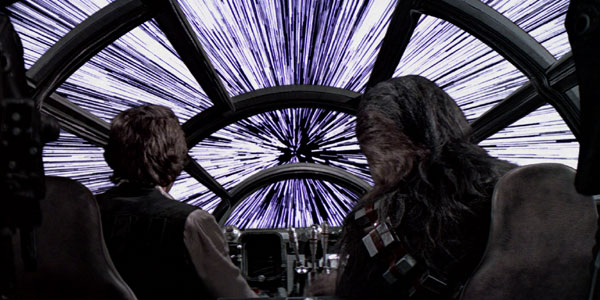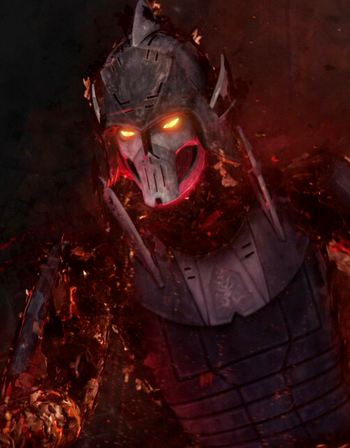Galactic History 101 - The Era of the Old Republic
1. Introduction
Welcome, students, to the first of four Shadow Academy courses that intend to examine known galactic history. Together, we will begin an exploration of our tumultuous past and examine the individuals and organizations of galactic antiquity. Our studies will take us back to a nearly forgotten age that includes the formation and eventual collapse of the Old Republic, the birth of the Jedi and the Sith Orders, and the beginning of their conflict. This course will end with a brief examination of a period of history known as the Dark Age, during which the modern Galactic Republic was eventually conceived.
Over thousands of years, conflict and the chaos that followed forced the citizens of the galaxy to adapt and change in order to survive. Because of this, some knowledge of the ancient past has been lost to the annals of time. Much of it is not out of reach and is likely undiscovered. However, enough remains that we can still present a relatively clear impression of the era.
2. The Dawn of Hyperspace and the Organization of Force Sensitives (10,000 BBY - 6022 BBY)
Approximately ten thousand years before the Battle of Yavin, scholars agree that one or numerous ancestral species made a discovery that would reshape our understanding of the galaxy. Hyperspace was an alternate dimension that could only be accessed through the use of faster-than-light (FTL) travel. The creation of the hyperdrive allowed access to this dimension. Hyperdrive technology allowed efficient faster-than-light travel through hyperspace, with ships able to travel tens, hundreds or thousands of lightyears in relatively short periods of time. This technology led to the creation of numerous galactic states, the most prominent of which was the Old Republic. The embrace of hyperspace as the common mode of space travel fundamentally changed the course of galactic history, allowing for exploration and interaction on a grand scale. To this day, ships rely on advanced hyperdrives as the only reliable method of FTL travel throughout the galaxy.

As various empires and states focused on their own growth, another influential organization was established. Approximately five to eight thousand years ago, various Force-sensitive individuals came together to form the Jedi Order. This group of Force sensitive individuals vowed to uphold peace and justice, and dedicated themselves to the study and use of the light side of the Force. Scholars are unsure exactl y where or when the Order was formed, but it is known that the Jedi acquired the world of Ilum soon after its inception. However, the Jedi would eventually use Coruscant as the de facto headquarters of the Order. The Jedi soon began to spread throughout the galaxy, gaining a reputation as reliable keepers of the peace, teachers, and diplomats in service to the people of the galaxy.
Further Reading
2.1 The Hundred Year Darkness and the Birth of the Sith
The Jedi Order quickly rose to become one of the most influential organizations in the known galaxy, gaining respect and recognition for their service and dedication to maintaining peace. Though records of the exact number of Jedi are scarce, it is estimated that the Order was comprised of tens, perhaps even hundreds of thousands of individuals from across the galaxy. However, the Jedi Order was about to face a new challenge emerging from within.
Approximately five to six thousand years ago, a rogue Jedi was born. This male individual grew up to become a member of the Jedi Order. Overtime, this Jedi became disenfranchised with the passive and stoic nature of the Jedi’s’ teachings. His opposition to the stoicism of their training and a hunger for knowledge led him to explore the Dark Side of the Force. Study of this forbidden knowledge provided him a new and dangerous perspective of the Force. A core tenet of the new philosophy he had adopted was that a Jedi’s true potential could only be achieved by tapping into the Dark Side. Ultimately, the rogue Jedi was exiled by the Jedi Order for this maverick dogma and branded an outcast. However, he had attracted numerous followers intrigued by his belief and use of the dark side. Many departed the Order and would later go on to become the first members of the Dark Jedi sect known as the Sith.
The schism of the early Order into the Jedi and the Sith (followers of the Light and Dark Side of the Force, respectively) led to a period of history referred to as the Hundred-Year Darkness. This era is widely considered to mark the beginning of a larger conflict between the two factions that continues to shape galactic affairs today. Sources of this period are scarce, though it is accepted among galactic historians that the forces of the Light and Dark likely waged war numerous times over many thousands of years.
Further reading
3. An Endless Struggle - Conflicts and Challenges of the Old Republic (6021 BBY - 1033 BBY)
During the Old Republic’s long existence, it was forced to face numerous opponents that threatened it. The most well known of these combatants were the Sith, though the dark side practitioners were by no means their exclusive enemies.
3.1 The Sith
The first of these known and recorded threats were the Sith themselves, who used their newfound power and influence to create vast empires built on the backs of slave labor. Most recorded information of the ancient Sith remains undiscovered or was destroyed by the Jedi Order, though it is common knowledge that the Sith fought countless wars with the Old Republic. Due to the nature of the Sith and their beliefs, they were considered to be perpetually at war against the Old Republic until the Sith were driven into hiding during the Dark age following its disintegration.
Some of the largest and costliest battles of the Old Republic era were fought between the Sith and the Jedi. The Great Scourge of Malachor was one such battle, and likely the most well known. However, others were fought with similar results, including an occupation of Coruscant and the building of a Sith Temple around six thousand years before the Battle of Yavin, the Battle of Takodana, and others. It is unlikely we will discover more detailed information about the Sith of old and the wars of which they fought, as the knowledge has been lost, hidden, or destroyed. But it is safe to say the Sith were the primary antagonist of the Old Republic for thousands of years.
During the Dark Age and the final days of the Old Republic, the Jedi-Sith war was fought, pitting the Jedi of the failing Old Republic against the totality of Sith forces approximately a thousand years before the Battle of Yavin. The majority of the Sith were eventually defeated by the Jedi Order and the Old Republic, though one remained: Darth Bane. After a time, even Bane was killed, likely because the Jedi were unwilling to allow a Dark Lord of the Sith to remain alive. Following this defeat, the unidentified apprentice of the Sith would remain in hiding for the next thousand years, developing intricate plots for galactic domination from the shadows.
3.2 Mandalorians
Considered to be some of the fiercest people in the galaxy, the Mandalorians were originally a people dedicated to the practice of war. The Mandalorian reputation of being a cunning and deadly fighting force was well deserved, however. The Mandalorian peoples of antiquity are often remembered as crusaders, leading great expeditions throughout the galaxy against those they considered their enemies, the Jedi Order counted among them. Furthermore, the Mandalorians also fought the Old Republic, most recently just over a thousand years before the Battle of Yavin. Their involvement in multiple wars against the Old Republic likely contributed to the warrior civilization’s downfall. The final major conflict between the Jedi and the Mandalorians left the planet of Mandalore a scorched desert, with its people forced to live in shielded colonies on the surface.
3.3 Zygerrians
Thousands of years before the Battle of Yavin, the Zygerrians ruled a large and influential slave empire. Numerous scholars of this very Shadow Academy suspect that the Zygerrians potentially supported the Sith empires of old to some degree, as well as other minor galactic powers or criminal organizations. As slavery was outlawed by the Old Republic and the Jedi Order, the empire was deemed an enemy of the Republic. The Jedi, likely with assistance from the Old Republic military, declared war against the empire. The Jedi were ultimately victorious, dismantling the empire and forcing the Zygerrians to conduct their business on the black market.
3.4 Other Challenges
Over the millennia, the membership and size of the Old Republic was likely similar in scope to its institutional descendant, the Galactic Republic. This meant that it had the responsibility to manage a massive swath of territory spread across the galaxy. Such a task is no small feat, even during times of peace. The complexity and sheer scope of administration during peacetime would have been extremely difficult, much the same as it is in the present day.
Therefore, it was no surprise that conflict forced the Old Republic to continuously adapt and cling to existence. War on a galactic scale likely intercepted or interrupted vital trade routes and supply lines, consumed or destroyed entire planet’s worth of resources, and caused serious hardship to billions, if not trillions of lives.
Further Reading
4. Dissolution of the Old Republic (1032 BBY)
In the last one thousand years of its existence, the Old Republic faced severe hostility on numerous fronts. The Republic had found powerful enemies throughout the galaxy that continuously pressed their advantage. Though the Jedi were powerful and numerous during this period, the Old Republic required a massive military force to defend its member worlds and interests. A standing army and star navy was not a new concept to the Republic, but consistent warfare damaged their economy, crippling the financial capability to manage the massive military it required to defend itself. What’s worse, the ability of the government to administer the wider Republic and its citizenry was severely eroded while the Republic struggled to remain afloat. It was also speculated that massive superweapons were constructed over these thousands of years with the ability to permanently damage or even destroy entire worlds.

The Jedi-Sith war of 1032 BBY would ultimately determine the fate of the failing galactic state. Though the war was short, it caused irreparable damage to the struggling Republic that could not be remedied. Though the Jedi managed to defeat the Sith during this conflict, the government of the Old Republic finally collapsed from its mounting internal struggles, leaving former member worlds to fend for themselves. The galaxy entered a brief and chaotic period of history known as the Dark Age. However, powerful and influential Core worlds wasted little time, coming together soon after the Old Republic’s collapse to form a new galactic state.
Further Reading
4. Conclusion
The collapse of the Old Republic was a bittersweet period of galactic history. Following thousands of years of warfare, expansion and steady decline, the dissolution of the galactic state happened around the same time to Jedi Order appeared to have defeated the once-powerful Sith. However, a group of influential systems quickly stepped in to fill the administrative void, forming the modern Galactic Republic. The era of the Old Republic was over; the Twilight of the Republic had begun. In the next course, we will cover the thousand year period of peace, the machinations of the Sith, and the first of a chain of events that led to the downfall of the Galactic Republic: the Naboo Crisis, and what followed after.
Please log in to take this course's exam